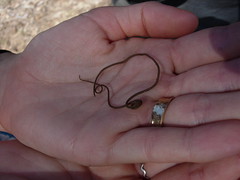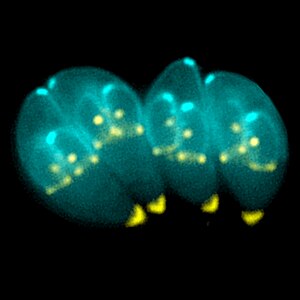805

Nature is filled with some of the most fascinating and bizarre things. From mind controlling parasites to zombie-d animals and insects, one close look at nature and it feels like something out of sci-fi.

Image courtesy http://www.missfidget.com/?p=6650
The Cordyceps fungus is probably nature’s way of keeping a check on the populations of insects. There are thousands of different types of Cordeceps fungi, with each being very specific to a particular insect species. The Ophiocordyceps unilateralis, for example, infects ants in particular. When into the ant’s system, it alters the behaviour of the ant to ensure it spreads its spores in the environment. Ants that are infected, referred to as zombie ants, wonder alone and perch themselves on branches, or leaves ensuring the viability of the fungus. Experts have witnessed that the ants generally chose a spot that is high in humidity, and have temperatures between 20-30 degrees making sure that the fungus survives. One can generally find a graveyard of almost 20-30 ants in a square meter. The fungus is so dangerous it can whip out entire colonies.
Gordian Worm (Photo credit: Gravitywave)
The horse hair worm normally lives in fresh water puddles, harmless and docile. But its initial years are quite sinister. For the larvae of a horse hair worm to hatch and mature it requires a host which is usually filled in by a cockroach, beetle or a grasshopper. Horse hair worm cysts are found abundantly in fresh water puddles and lakes where the unsuspecting victims first consume these cysts. Once inside the gut of its victim, the cyst dissolves, and the larva is released. The larva feeds on the tissue of its host, and develops into an adult worm. The development of the worm may take several months, and during this process the worm moults several times inside the insect, growing larger and larger each time!! Once mature, the worm infects the host’s brain, making it attracted to water, thus returning the worm to its natural habitat. This obsession with water proves fatal to the host, who eventually dies by drowning, and the worm returns to its lake, ready to start the cycle all over again. Luckily for us, the horse hair worm is not harmful to humans and other animals, but is surely death sentence for an unsuspecting insect
(Photo credit: Wikipedia)
Snails generally love shade and are shy to come out in the open. But this is not the case when a snail is infected by Leucochloridium paradoxum. The primary host of this parasite are birds. The worm matures and reproduces in the gut of birds and spreads its eggs through bird droppings. The dropping loaded with parasite larvae are consumed by snails. But snails are not the most alluring prey for the parasites primary host. The worm is quite smart, has a way around this too! When ingested by the snail it makes its way to the snail’s tentacles, and mimics a vibrant, pulsating grub or caterpillar. A snail is generally shy and loves dark places, but when affected, it is compelled to go out, away from the shade and expose itself in the open. The pulsating tentacles are likely to catch the attention of a bird, and the parasites thus complete its deadly cycle.
T. gondii constructing daughter scaffolds within the mother cell. (Photo credit: Wikipedia)
Toxoplasma gondii
Discovered in 1908, this is one of the most fascinating parasites out there.
Its primary host is the cat (wild and domesticated), where the parasite spends the sexual part of its lifecycle. But that is not the interesting bit, when the parasite is in its juvenile stage it is hosted by other warm blooded animals (including humans). The most likely host for Taxoplasma, in its juvenile phase is the rodent and that is when it starts getting fascinating. When a rat is infected by Taxoplasma gondii, there is a dramatic change in the rat’s behaviour. A typical rat stays away from cats and wants nothing to do with them, but when a rat is infected by Toxoplasma gondii, it becomes less afraid of its mortal enemy, in fact studies show, that rats infected by this parasite are perversely attracted to cats! These bugs literally take control of the rat’s brain and urge them closer to the cat. It has been observed that the bug infects the amygdala (the fear centre) of the rat’s brain. But strangely the rats response to other danger stimuli is never hampered. When checked for their response to shock, the infected rats seem to have the same response as normal rats. The bottom line, the parasite actually ensures the safety of its host, so that it is consumed by a cat, and a cat only!!
It was believed that toxoplasma had no harmful effects on humans, but recent scientific studies show something very different. It is believed that Toxoplasma gondii, can in fact manipulate with the biochemistry of our brains too.






5 comments
This is potentially very wonderful in terms of having an effective treatment for certain people. Many thanks!
Thanks for reading our post!
Your deduction is on the same lines as many in the scientific world. In fact there are many scientist who are taking a closer look at many psychological diseases through the Toxoplasma lens.
You'll find these papers interesting http://onlinelibrary.wiley.com/doi/10.1111/j.1365-3024.2009.01131.x/full, http://europepmc.org/abstract/MED/21890329/reload=0;jsessionid=vKXeKaI0jQGvAcm6dg5H.8
This parasite may actually change our view on many psychological disorders!!
Very interesting post. Thank you. You wrote "It is believed that Toxoplasma gondii, can in fact manipulate with the biochemistry of our brains too."
I wonder if certain psychological disorders can be, in part, explained by this phenomenon.
Mother nature is intense and amazing!
More and more recent research indicates that microbes are quite influential when it comes to Neuro-Biochemistry. For example psychobiotics is now a potential scientific reality. In some cases, the pathway is well understood and in some cases studies are yet to identify the molecular pathways.
References from my earlier posts:
1. http://varuncnmicro.blogspot.in/2015/08/microbes-for-thought.html
2. http://varuncnmicro.blogspot.in/2014/05/does-toxoplasma-drive-you-crazy.html
[…] its name from its predatory behaviour, as it hunts and kills other insects by injecting them with a venomous saliva. Its bite is painful and causes an itchy […]